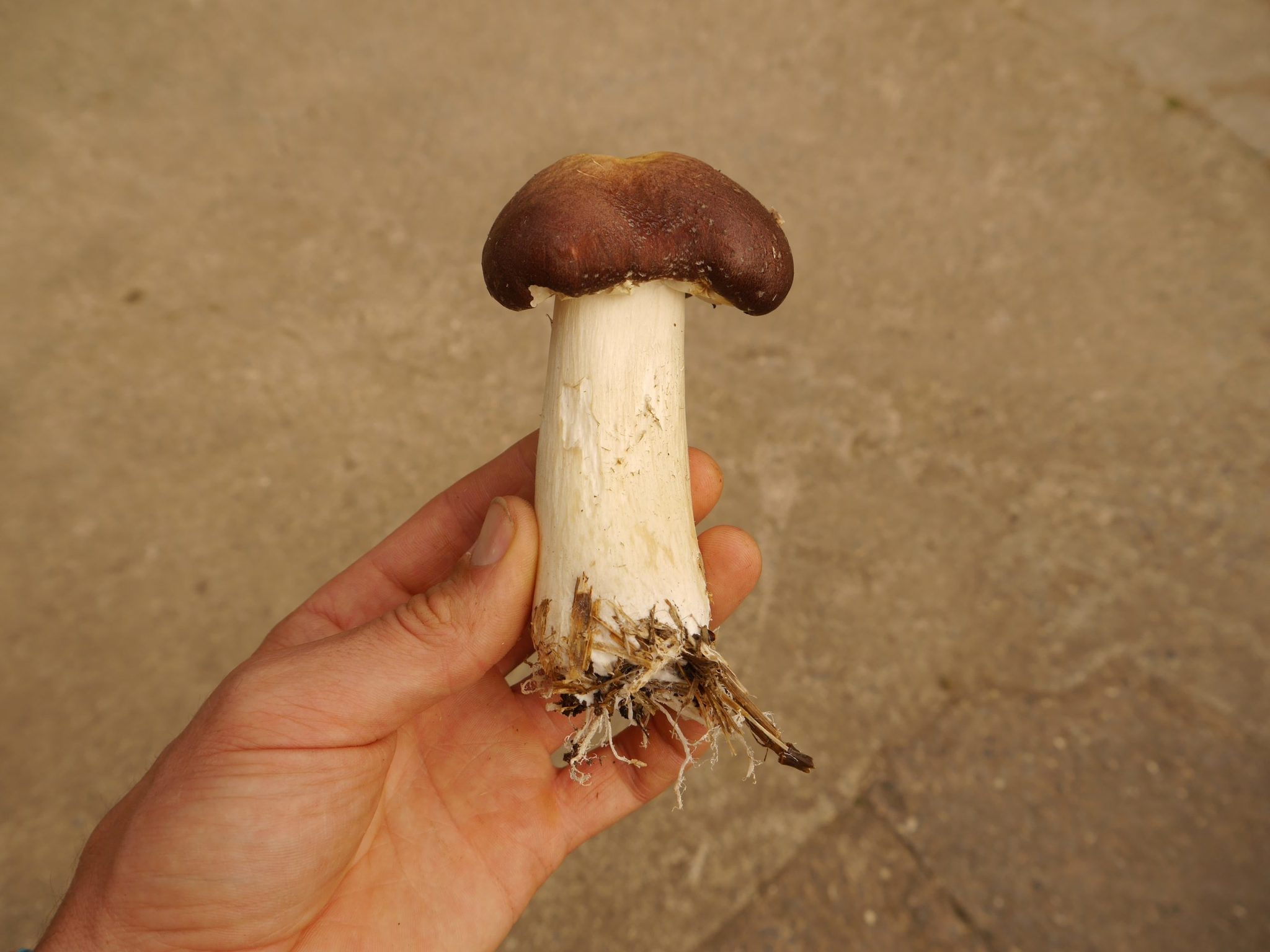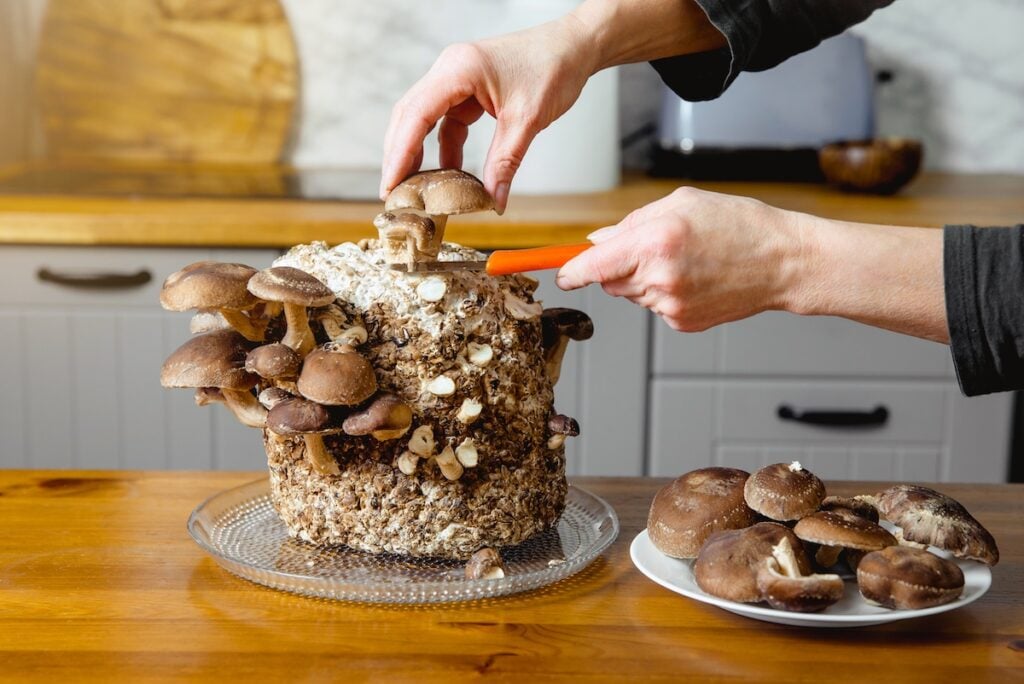Is growing your own mushrooms something you want to do but don’t want to do inside? An outdoor mushroom bed is a great alternative.
What kinds of mushrooms can you grow outside? You can put some types of mushrooms, like the oyster, shaggy mane, pioppino, or elm mushroom, outside in a mushroom bed. There are only three things you need to grow: wood chips, spawn, and a place that stays moist.
Many people ask me if they can grow mushrooms outdoors in their garden. You sure can! This article will show you a nice and simple way to do it with a mushroom bed outside.
It’s worth mentioning that you can also grow mushrooms in your garden on logs. If you’d also like to learn how to grow mushrooms on logs, we have a separate guide for that.
Growing mushrooms outdoors is a fun, rewarding way to get tasty edibles from your garden. While many people think of mushrooms as an indoor crop, a number of delicious, easy-to-grow mushroom varieties thrive outdoors. From woody log gardens to straw-bale beds, you can cultivate mushrooms outside using a few simple techniques.
Benefits of Growing Mushrooms Outdoors
Growing mushrooms outside has several advantages:
- Takes advantage of garden space not suitable for sun-loving plants
- Provides organic matter and nutrients as they break down material
- Low maintenance compared to tending vegetables or flowers
- Unique edibles not found at the grocery store
- Some species produce for years from a single inoculation
Outdoor mushrooms are a great project for beginners since they don’t require the sterile techniques of indoor growing They also produce reliably with minimal care
Best Mushrooms to Grow Outdoors
Good outdoor mushroom varieties include
-
Oyster – fast-growing, aggressive colonizers on straw or wood Include blue, pink, golden, Phoenix
-
Wine Cap – thrives on straw, wood chips, sawdust. Robust and resilient mushrooms.
-
Shiitake – prefers hardwood logs like oak, maple, beech. Enjoyable to grow on totem logs.
-
Lion’s Mane – produces on hardwood logs. Unique, cascading appearance.
-
Reishi – an easy wood-loving medicinal mushroom. Also grows on logs.
-
Turkey Tail – decomposes logs, stumps, and wood debris. Excellent for gardens.
-
Chicken of the Woods – colonizes living and dead trees. Striking shelf-like appearance.
Start with 1-2 easy varieties like oyster or wine cap to get your feet wet in outdoor mushroom gardening.
Growing Mushrooms Outdoors in Beds
One of the simplest ways to grow mushrooms outside is by inoculating beds of straw, wood chips, sawdust, or other bulk substrates. This mimics how mushrooms expand in nature.
How to make an outdoor mushroom bed:
-
Choose a shady site with fertile soil and filtered sunlight
-
Layer spawn and substrate such as straw, wood chips, cottonseed hulls, etc.
-
Keep bed consistently moist as mycelium colonizes the material
-
Water as needed once established to maintain moisture
-
Harvest mushrooms as they form!
Straw-loving oyster mushrooms or wine caps, a wood chip loving mushroom, are good beginner options for outdoor beds.
Growing on Logs Outdoors
Inoculating logs with mushroom spawn is rewarding and sustainable. As the mushrooms grow, they decompose the log and create edible fungi.
How to grow mushrooms on logs:
-
Obtain fresh-cut logs from disease-free hardwood trees like oak, maple, poplar, beech, alder.
-
Drill holes around the log. Insert dowels or plug spawn into the holes.
-
Seal inoculation sites with cheese wax to retain moisture.
-
Place logs in a shady spot and wait several months for mycelium to spread.
-
Soak logs before first flush to initiate pinning. Then keep logs moist.
-
Harvest mushrooms as they mature. Certain logs produce for years!
Good wood-loving mushrooms for logs include shiitake, lion’s mane, and oyster varieties.
Caring for Outdoor Mushrooms
Outdoor mushrooms are lower maintenance than indoor crops. But they still benefit from some care:
-
Watering – Supply consistent moisture, never allowing beds or logs to completely dry out.
-
Weeding – Remove competing weeds/plants around logs or beds.
-
Fertilizing – Top dress beds with compost or manure to replenish nutrients.
-
Pest control – Address slugs, insects, or animals disturbing the site.
-
Shade – Install shade cloth barriers if the area gets direct, intense sunlight.
Take a hands-off approach to allow mushrooms to fruit naturally but address any issues as needed.
When to Harvest Outdoor Mushrooms
Knowing when to pick mushrooms is key. Look for signs your variety is reaching maturity:
-
Oysters – Harvest before edges of caps start to curl upward
-
Wine caps – Pick when caps expand but before edges flatten
-
Shiitakes – Look for caps opening fully with curled under edges
-
Chicken of the Woods – Cut when brackets are moist and vibrant, before drying
-
Lion’s Mane – Harvest just before spines start to deteriorate
For best flavor, avoid waiting until mushrooms release spores.
Use sharp scissors or knives to cut mushrooms at their base. Twisting and pulling can damage developing fungi.
Storing Your Outdoor Mushroom Harvest
Enjoy your harvested mushrooms right away, preserve via drying or freezing, or extend their shelf life with these storage tips:
-
Place unwashed mushrooms in paper bags in the refrigerator. Most stay fresh for 1-2 weeks.
-
Brush debris off mushrooms but don’t wash until ready to use. Excess moisture shortens shelf life.
-
Trim stem bases and wrap mushrooms in a dry paper towel then seal in a zip-top bag for short term storage.
-
For long term freezer storage, clean, slice, and spread mushrooms on a baking sheet before freezing. Then transfer to bags.
With multiple growing options for cultivating mushrooms outdoors, it’s easy to start harvesting your own organic, hyperlocal mushrooms at home. Try adding a mushroom patch to your garden this season!
Harvesting Your Mushrooms

When you have garden giants, make sure you pick them before they get too big.
People say that the cap starts to fall apart quickly when it opens too wide, and bugs and other insects like to get inside.
We were there to pick them just about on time. If you get them nice and young, these mushrooms are absolutely delicious.
You can cook them up and enjoy them the same way you would many other types of mushrooms.
It Got Contaminated
The world is full of a surprising amount of little critters. In any given sample of dirt or air, there’s likely multiple different types of bacteria, mold, and yeast.
You don’t have as much control over the environment and can’t be sure that the mushrooms will be clean when you grow them outside in a bed.
It’s just a risk you take when growing mushrooms outdoors. You want your mycelium to take hold and beat out any other germs that might try to claim the same space.
Outdoor Mushroom Beds | The Easiest Way to Grow Edible Mushrooms in Your Garden or Back Yard!
FAQ
Is it safe to grow mushrooms outdoors?
What is the easiest way to grow mushrooms for beginners?
How do I grow mushrooms outside?
Growing outdoors involves creating a ‘raised bed’ which will be a container that contains your growing medium and mushroom spawn/spores. This growing bed will be separate to the rest of your garden or yard, and will only contain your mushroom grow.
How to grow mushrooms naturally?
Wood is also a nice natural material to use. This type of grow bed made of brick will also work well for storing your mushroom growing substrate and spawn. On a budget, you can also use a plastic tote to grow your mushrooms in.
Can mushrooms grow outside?
The mushroom substrate should not be heavily disturbed as the mycelium attempts to grow. Lastly, keep in mind that your mushrooms may never grow with an outside grow method. Contamination outside is a very possible issue, and this will completely stop your grow. Unfortunately, you have to simply roll the dice on this and take a chance.
How to grow mushrooms in a Grow bed?
Place your grow bed in your ideal spot outside according to the directions provided above. As mentioned, this will be a in a mostly-shaded spot outside, where occasional sunlight may strike. Keep it away from specific water drainage areas, also. Fill your bed with your mushroom substrate, about halfway to the top, leaving room for another layer.
- The Ultimate Guide to Growing Strawberries in Raised Beds - August 8, 2025
- No-Dig Garden Beds: The Easiest Way to Grow a Beautiful Garden - August 6, 2025
- How to Protect and Preserve Wood for Raised Garden Beds - August 6, 2025

